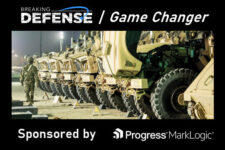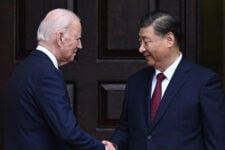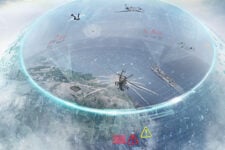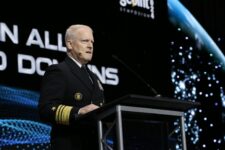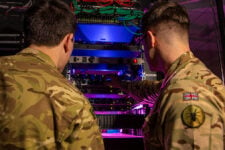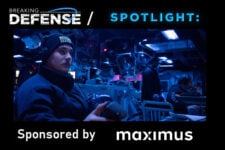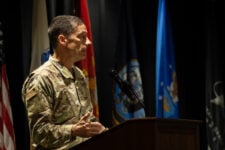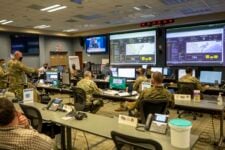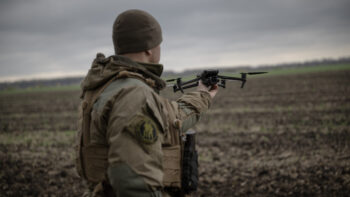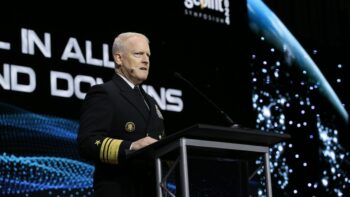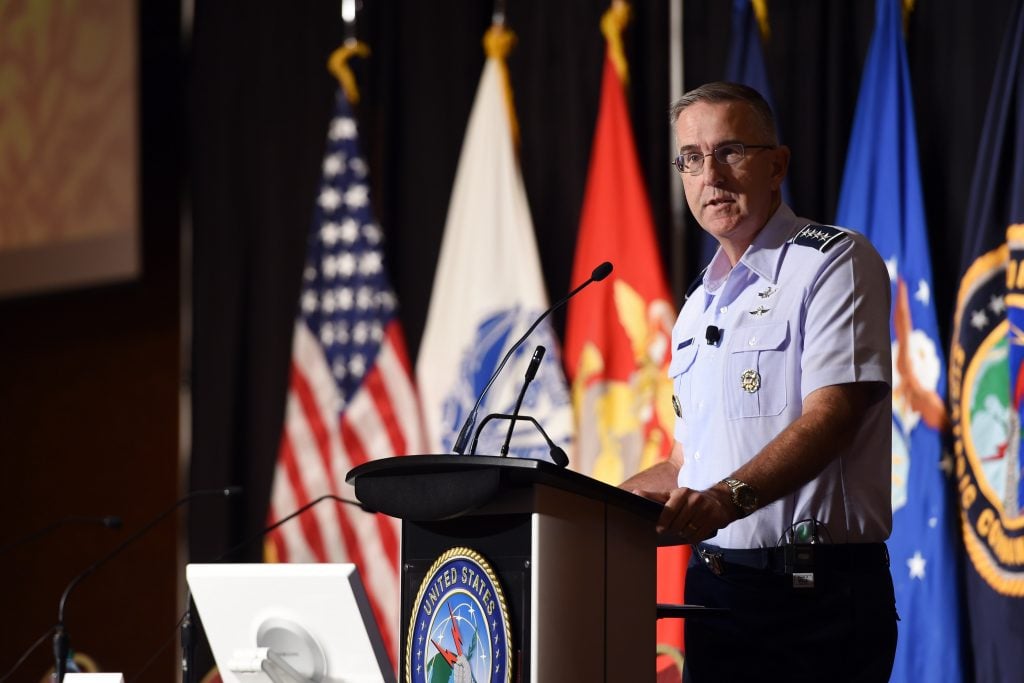
Gen. John Hyten at 2018 STRATCOM deterrence conference. (DoD)
WASHINGTON: The central difference between the Pentagon’s new Joint Warfighting Concept (JWC) and the military’s past approach is the recognition that space and cyberspace must be both protected and utilized — or else the data crucial to winning on the ground, in the air and at sea will be unobtainable, says Gen. John Hyten, vice chair of the Joint Chiefs of Staff.
“You have to be able to understand space and cyber” to achieve All Domain Operations, he told an audience at the National Defense Industrial Association (NDIA) today, during a roll-out of the new NDIA Emerging Technologies Institute.
Hyten explained that the JWC is an “aspirational” document, designed to guide the American way of war for the next 30 years. (It was signed on March 31 by JCS Chair Gen. Mark Milley, and shortly thereafter by Defense Secretary Lloyd Austin — although that fact was only revealed in mid-June.) However, he stressed, it now has to be fleshed out with doctrine and capabilities, as well as honed to accommodate what actually is achievable with the resources available.
The first iteration of the JWC, he went on, was based on simply improving upon the long-standing US strategy of gathering and using “ubiquitous” information to coordinate forces and structure battles. But when put to the test in a war game this past October, the JWC “failed” to produce a victory against an “aggressive red team” emulating peer competitors China and Russia.
“It failed in many different ways. We had basically attempted an ‘information dominance’ structure where information was ubiquitous to our forces just like it was in the first Gulf War, and just like it has been for the last 20 years,” he said. “Well, what happens if right from the beginning that information is not available? And that’s the big problem that we faced.”
Hyten said the effort then “had to take a step back” to reorient and refocus, with a new emphasis on the space and cyber domains.
“The concept we came up with is referred to now as ‘expanded maneuver,'” he said. “And it’s expanded maneuver in space and time. In every area that an adversary can move, you have to figure out how to fill that space in time, before they can move.”
The gist of expanded maneuver is figuring out “how do I aggregate my capabilities to provide significant effect, and then how do I disaggregate to survive any kind of threat?” Hyten explained. “We actually have not done that, really, for a long time, maybe ever.”
But the battlefields of tomorrow will require US forces and firepower to “aggregate” to attack, and rapidly disperse in order to survive fast-paced adversary “long-range fires” from all domains, he continued. “If you’re aggregated and everybody knows where you are, you’re vulnerable, but you have to aggregate to mass fires.”
The Importance of JADC2
This is where the JWC’s heavy focus on tools like artificial information and machine learning, as well as the virtual battlespace environments enabled by cloud computing under Joint All Domain Command and Control (JADC2), come into play.
“It could be a virtual aggregation from multiple domains, and acting at the same time under a single command structure that allows the fires to come in on anybody, and allows you to disaggregate to survive that,” Hyten said. “That is a simple, simple thing to say. That is aspirational. That is unbelievably difficult to do.”
In the JWC, he explained, “the goal is to be fully connected to a combat cloud that has all the information, that you can access at anytime, anyplace. You can pull it all together, and with all-domain command and control, figure out the best data and be able to act quickly on that.”
JADC2 is one of the four JWC “supporting concepts” that now are known as “functional battles,” Hyten explained. The other three are joint fires, contested logistics and information advantage. And all four of those function battles are challenging and remain “aspirational,” he stressed.
For example, he said, contested logistics is “really difficult,” noting that the last time the US had to fight in circumstances where US facilities abroad and at home were both under attack was in WWII. “So, contested logistics has been an area of rich study rich conversation, and we’re changing our entire logistics approach.”
Likewise, the idea of joint fires is both a huge challenge and somewhat controversial. Noting that he’d been “criticized for saying this,” Hyten explained that “in the Joint Warfighting Concept, fires come from all domains and all services, no restrictions.
“Why? Because when the fires come from all domains and all services with no restrictions, the adversary can’t figure out where they’re coming from, and they have no way to defend themselves against them. Now, that’s, that’s a purely aspirational requirement, but I hope everybody can see that if you can do that, you would change the equation on any future battlefield.”
Finally, information dominance, he explained, “is the summation of those three elements, really, all in one… And that’s where some very significant requirements come in,” he said.
The four new “strategic directives” issued by the Joint Requirements Oversight Council (JROC) this month, Hyten said, therefore are setting the stage for how the services make those joint functional battles possible. Hyten signed off on those strategic directives in late June.
The more active role for the JROC, pushed through by Hyten as chair, has resulted in some push back by the services, Hyten admitted.
“To be honest … the services the first six months were kind of fighting that process,” he said. “I know you’re very shocked to hear that,” he added to audience laughter.
Now, however, the services have realized that the creation of strategic directives “feeds operations, and feeds budget, and feeds acquisition” processes to allow the services to significantly speed up weapons development and fielding.



